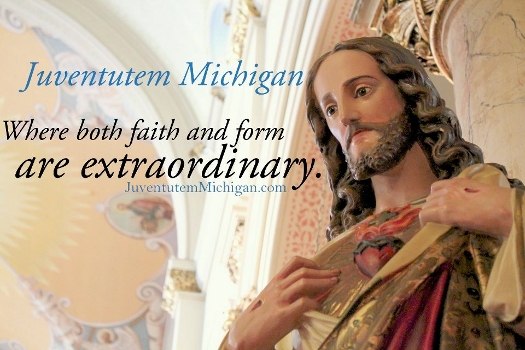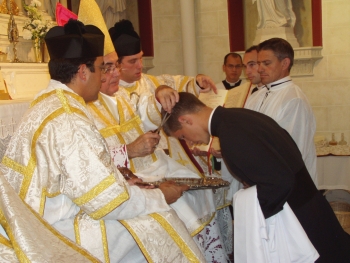
"I will go in unto the Altar of God
To God, Who giveth joy to my youth"
Tridentine Community News (June 16, 2013):

Ordination to the priesthood is a great grace that transforms the fundamental character of a man. It is more than just graduation from an educational institution, and indeed more than receiving a professional certification such as passing a bar exam or obtaining a license to practice medicine. Ordination forever gives a man the ability to forgive sins in the name of Christ, and to change ordinary bread and wine into the Body and Blood of our Lord.
If you have read articles or liturgical books pertaining to the Tridentine Mass, you may have come across the expression, “Minor Orders”. That term refers to the steps that a candidate for the priesthood in the Western tradition progresses through on his way to priestly ordination.
In his 1972 letter Ministéria Quædam, Pope Paul VI abolished the system of Minor Orders and created the simplified steps now followed by seminaries that primarily focus on the Ordinary Form:
Admission to Candidacy for Major Orders: This is generally provided after a seminarian has committed himself to the path towards priestly ordination.
Institution to the “ministries” of Acolyte and Lector: Essentially the same as those described below in the Tridentine section. Note that laymen not in seminary may also be instituted to these ministries.
Ordination to the (transitional) Diaconate: Generally one year before priestly ordination, a seminarian is ordained as a Deacon, the first of the Major Orders. A Deacon can assist the celebrant at Holy Mass in certain ways not permissible to others not ordained to that state. He can witness weddings and perform baptisms. He has the same privileges accorded to Permanent Deacons, men who do not progress to the ordained priesthood.
The 1988 establishment of the Fraternity of St. Peter and other subsequent traditional priestly groups prompted the Vatican to re-authorize the system of Minor Orders for seminaries primarily oriented towards the Tridentine Mass. The steps are as follows:
Tonsure: The name refers to the ceremonial clipping of hair from the head of a seminarian. It represents a formal commitment to a seminary community, and the entry to the clerical state. It is after Tonsure that a seminarian begins wearing the cassock instead of civilian clothing. Even though he has not yet been ordained as a Lector, he can read or chant the Epistle at Mass.
The orders of Lector, Porter, Exorcist, and Acolyte: These four individual orders are generally conferred together. These are what are officially referred to as the Minor Orders, though that term has come to represent the entire, more elaborate system we are currently describing. A Lector is authorized to read a broader spectrum of Lessons at Mass than one who has only received Tonsure. A Porter is the doorkeeper to the church (think Fr. Solanus Casey). An Exorcist is largely a ceremonial role, authorized to administer water to a priest during sacred functions. (Only a priest can exorcize demons.) An Acolyte is the formal name for the two principal altar servers at the Tridentine Mass. (Today’s lay acolytes are merely authorized substitutes for the originally-intended ordained Acolytes.)
Subdeacon: This stage represents entry into the clerical state. In the Western tradition, it commits the recipient to celibacy. A Subdeacon by definition may perform all of the functions of the Subdeacon at a Solemn High Mass, unlike so-called “straw” Subdeacons who have not been so ordained.
Deacon: Same as in the Ordinary Form system. Only a Deacon, Transitional or Permanent, may serve as Deacon in a Solemn High Mass.
Equivalence For Liturgical Purposes The main questions that the elimination of the Minor Orders present concern the admissibility of those progressing according to the Ordinary Form norms to certain liturgical roles in an Extraordinary Form Mass. Fortunately, the Ecclesia Dei Commission has issued rulings clarifying what is permissible:
One who has been admitted to Candidacy for Major Orders is deemed equivalent to one who has received Tonsure except with regards to serving as Subdeacon.
An instituted Acolyte may serve as Subdeacon at a Solemn High Mass, though with the same restrictions as one who has only received (Tridentine) Tonsure, described above. Because the Ordinary Form ministry of Acolyte may be conferred on a layman, and not only on one who has been admitted to Candidacy for Major Orders, a layman Acolyte functioning as Subdeacon may not wear a biretta or a maniple.
Only someone who has been ordained to the Subdiaconate or higher may handle the sacred vessels during a Solemn High Mass.
Tridentine Masses This Coming Week
- Mon. 06/17 7:00 PM: Low Mass at St. Josaphat (St. Gregory Barbarigo, Bishop & Confessor)
- Tue. 06/18 7:00 PM: High Mass at Assumption-Windsor (St. Ephrem of Syria, Deacon, Confessor, & Doctor)





No comments:
Post a Comment